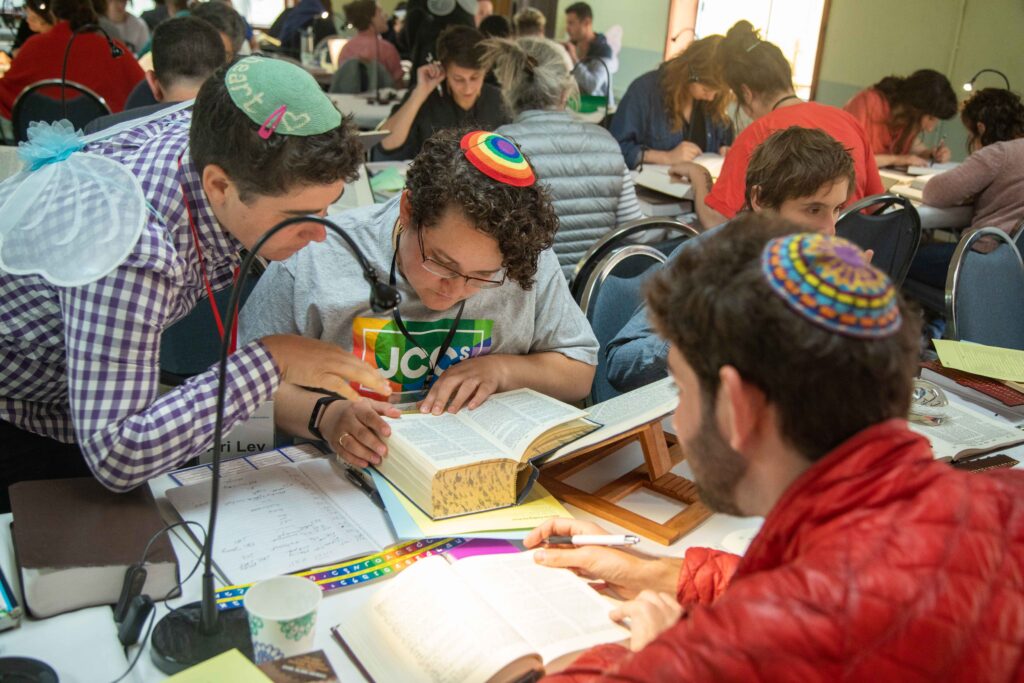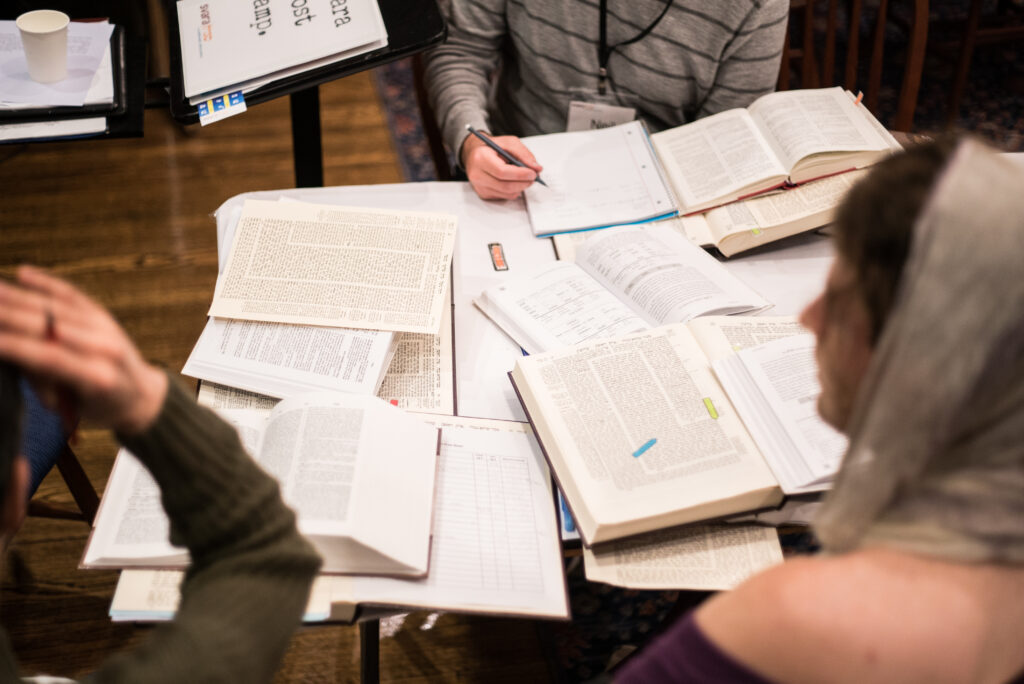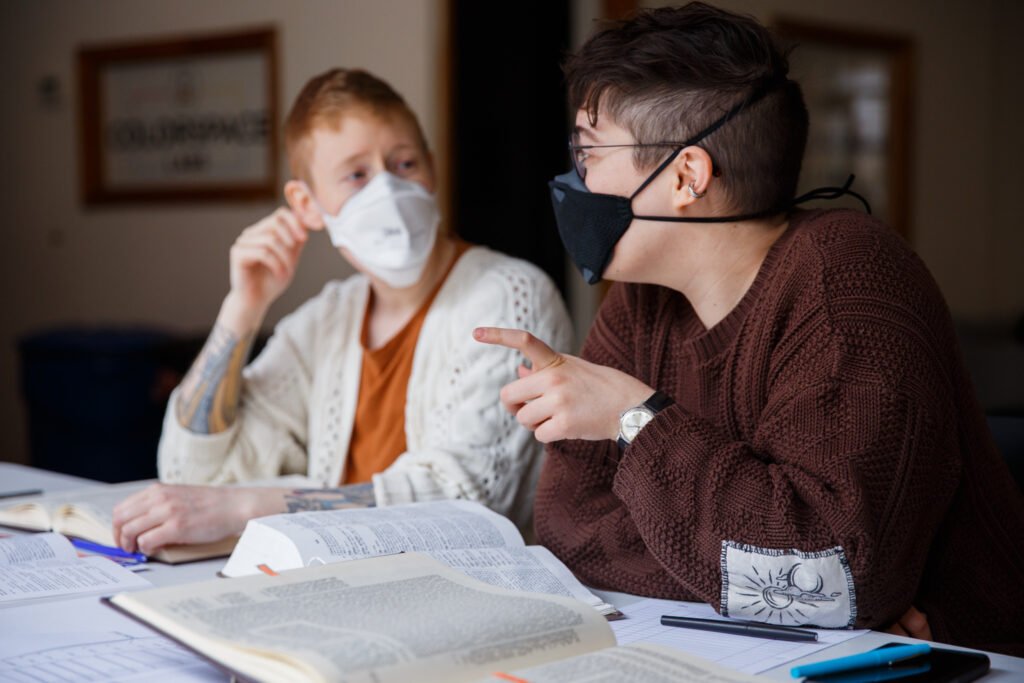This Saturday night, Jews around the world will observe the holiday of Tisha B’Av, which is a strange holiday for us SVARA-niks. On this day we mourn the historic destruction of the Temple in Jerusalem. The customs of the holiday include fasting, the recitation of liturgical dirges known as kinot (קינות), and the communal reading and study of the Book of Lamentations, which depicts in poetically gruesome detail the destruction of Jerusalem and the exile of its inhabitants. At SVARA, however, our focus is rarely on the Temple but on what emerged from its destruction—the Talmud! Option 3 Judaism! The radically queer tradition that continues to evolve and thrive in our breath and bones today! So how are we supposed to engage with this holiday? How does its somber ethos of devastation and isolation connect to our renewed sense of possibility and community that we’ve cultivated in our glittery bet midrash? In other words, how do we mourn for something we may not really be mourning for?
There, I said it. As a rabbi, it feels like another coming-out of sorts—admitting that I fundamentally don’t understand why our religious tradition has us mourning destruction that actually created space for us to exist. I suppose I can relate to it on a personal level—there are some friendships and relationships that have ended in order for me to become the person I am today. From time to time I miss the good times I had with those people, but the mourning of those relationships is not ritualized in my life like Tisha b’Av.
Maybe I need to relate it to something bigger. A few years ago a deeply disturbing thing happened to me in a synagogue I worked in and it slowly destroyed my desire to be a pulpit rabbi. The grief I experience from that trauma comes up again and again in my life, often unexpectedly at the strangest of times and places. The mourning is related to the loss of a certain kind of idealism, an innocence maybe, about what a sacred-space can be. But even so, without this experience, I’m not sure I would have had the clarity of heart and mind to be able to enter the work at SVARA with such certainty. Thank G!DESS I did, because SVARA has reminded me what real sacred-space can be.
But even in this example, I don’t mourn for my life as a pulpit rabbi because the rabbinic life I have at SVARA is more than I could have ever imagined. The mishkan (משכן), the holy dwelling of learning and exchange that I’m a part of, endeavors to dismantle hierarchies and replace ableism with access. It recognizes front-and-center antiracism and decolonization as mitzvot (מצות) that our radical tradition may not have explicitly named, but clearly built in the blueprints to achieve. I feel the dwelling presence of G!D, Shekhina (שכינה) in the spaces we make together at SVARA in a way that I never could when I was on the bimah and my fellow travelers on this Jewish path were stuck in the pews. I was stuck too, but I didn’t know it until the whole system began to disintegrate underneath me, revealing the rot and decay of deep hypocrisy and a whole array of shortcomings that ultimately contributed to the regular dehumanization of so many.
When I look back on it now, it’s not that I mourn being a pulpit rabbi—I mourn for the “me” that was lost there, the “me” before the hurt and the betrayal, the “me” without those scars. It’s a kind of nostalgia, a longing for something that may have been an illusion all along. Part of the mourning I feel is also for the lack of clarity I had then, which is a clarity I have now because of SVARA: a clarity around my core values and my inherent self-worth. Had I had that clarity back then maybe I could have utilized it to make things better where I was. Sometimes we can reimagine the past with the hard-earned wisdom of the present. That’s what I believe our fairy rabbi ancestors did. Here’s how:
In Masechet Berachot (ברכות), the very first tractate of the Talmud known as “Blessings,” our fairy Rabbi ancestors tackle this radical new concept called “prayer,” known as תפילה which comes from the root פלל (Jastrow Dictionary pg. 1182-1183), meaning “to arbitrate, intercede, to argue, to debate” and “to pray.” From the get-go, our Rabbis were imagining something very different than the system of Temple sacrifice-as-worship from which their communities had emerged. The Temple service was all about strict adherence to precise laws and formulas for celebration and expiation as the High Priests required. Prayer, for the Rabbis, was a deep interchange between the individual and their Creatrix. But still the Rabbis longed for the discipline and communal ritual that had been cultivated in the Temple. So how do you do something radically new but connect it in a meaningful way to a lineage that came before?
As we’ve been learning in Mishnah Collective (it meets Monday-Friday for 30 minutes at 10:30am PT / 11:30am CT / 1:30pm ET and it’s EVERYTHING <3 ), Berachot jumps right in with this prayer, “the Shema” (שמע). The Mishnah doesn’t define exactly what that means, but rather presumes that we already know what it is, and maybe they did—maybe the recitation of “Shema” was something that had organically developed as a practice of resistance amongst the yiddim of occupied Roman Palestine. Maybe it began as a bedtime calming ritual before entering the mysterious world of sleep and dreams. One way or the other, the “Shema” seemed to be a known element, and our fairy Rabbi ancestors connected its recitation to the lineage of the Temple by focusing on the precision of the times in which it was to be said, both in the morning and the night.
Typical of the Rabbis in the Mishnah, there are several beautiful descriptions of how to determine those times, often more poetic than precise. Some, however, explicitly link the timing of the recitation of “Shema” with the timing of certain practices performed by the priests or kohanim (כהנים) in the days of The Temple. In doing so, they remind us that part of the rabbinic project is moving Judaism away from a top-down approach where priests serve as intermediaries between the people and G!DESS and towards us serving in these ritual roles for ourselves. The idea is to treat our own spiritual lives as Temples within themselves.
So now we arrive at the Gemara, that later generation of Rabbis trying to figure out WTF to do with the Mishnah. In response to the Mishnah’s various options for understanding the timing of the recitation of the evening Shema, the Rabbis of the Gemara try to divide the night into precise divisions of hours known as “watches” (משמרות from the root שמר, Jastrow pg. 1600 meaning “to guard, protect, observe, keep”). Then we get the following:
אָמַר רַב יִצְחָק בַּר שְׁמוּאֵל מִשְּׁמֵיהּ דְּרַב
שָׁלֹשׁ מִשְׁמָרוֹת הָוֵי הַלַּיְלָה, וְעַל כָּל מִשְׁמָר וּמִשְׁמָר יוֹשֵׁב הַקָּדוֹש
בָּרוּךְ הוּא וְשׁוֹאֵג כַּאֲרִי, וְאוֹמֵר: ״אוֹי לִי שֶׁחֵרַבְתִּי אֶת בֵּיתִי וְשָׂרַפְתִּי אֶת הֵיכָלִי וְהִגְלִיתִי אֶת בָּנַי לְבֵין אוּמּוֹת הָעוֹלָם״ (ברכות ג.).
Rav Yitzḥak bar Shmuel said in the name of Rav: The night consists of three watches, and over each and every watch the Holy One, Blessed be He sits and roars like a lion, and says: “Woe to Me, that I destroyed My house, burned My Chamber and exiled my children among the nations of the world.” (Berachot 3a)
The root of the word “to roar” in Hebrew is amazing. שאג can also mean “to shout” or “to be excited.” According to the Jastrow Dictionary, the root שאג is related to the root שגג which can mean “to be excited, confounded, to err, do wrong inadvertently, to act under a wrong impression.” While the most logical outside translation of this root is “to roar” based on context, it’s striking to imagine G!DESS Themself having mixed feelings about this Temple thing. Maybe G!DESS is a little excited too about the possibilities born out of this removal of the Temple as the central locus of Jewish identity-formation. Maybe G!DESS is confounded by the level of destruction that occurred, both of the physical space itself and the loss of community and personal ties in the devastation of exile. Maybe G!DESS roars from a place of recognizing Their own errors and the errors of humanity, both inside and outside the Temple’s walls, that perhaps allowed for such brutality to slowly grow, take root, and unleash itself into the world.
Our fairy-Rabbi ancestors dared to imagine G!DESS’s feelings, and audaciously gave Them language. In so doing, I believe our ancestors gave a Divine voice to their internal struggles and contradictions around their experiences of mourning the destruction of the Temple. The Talmud is inviting us into a complex relationship with mourning. This invitation becomes a way to look to the past and sort through the rubble to determine what nourishment can be gleaned, and to honor the painful experiences, even the brutal ones: not because we try to glorify physical, emotional or spiritual violence, but because these experiences are part of who we are. There can be mourning that also has excitement and self-reflection within it, which just might cull up a roar within us too. May this Tisha b’Av be an opportunity in sacred space or sacred time to wrestle with our own mourning, whether it’s for the Temple or any other structures that are no more in our imminent lives. May we be blessed to find ourselves in this process, and connect more deeply with one another, so that one day our mourning may be turned to dancing (Psalms 30:11). Dance party Sunday night, anyone? <3







